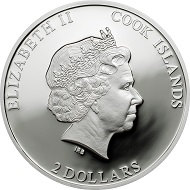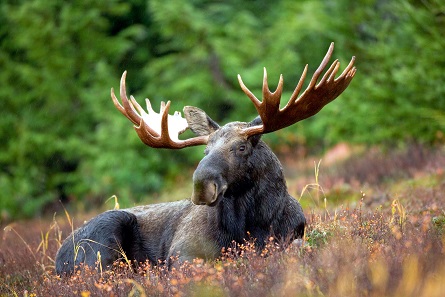April 7, 2016 – The first two 2016 issues of the “World of Hunting” series, which Coin Invest Trust designs for the Cook Islands, are dedicated to the Alpine Ibex and the Moose. Just like all its predecessors in the series, the stunning interplay of relief and colour renders the coins a captivating sight.
Cook Islands / 2 Dollars / 35 mm / 1/2 oz. Silver .925 / Design: Coin Invest Trust / Mintage: 2500.
The obverse shows the Ian Rank-Broadley portrait of Elizabeth II as well as her name, the name of the issuing state, and the nominal value.
The reverse, in keeping with the style of its predecessor coins in the series, depicts two Alpine Ibex and two Moose respectively, of whom one animal each is set in colour, in its natural habitat. Above, the inscriptions ALPINE IBEX and MOOSE respectively are engraved, plus the name of the series, WORLD OF HUNTING, with a stylized branch, and the year of issue.
Cook Islands / 2 Dollars / 35 mm / 1/2 oz. Silver .925 / Design: Coin Invest Trust / Mintage: 2500.
Alpine Ibex
The Alpine Ibex, or Capra ibex, belongs to the family of wild goats. In its habitat, the Alps, it lives at heights of up to 3500 m. The Alpine Ibex feeds on grasses and herbs, smaller bushes and tree shoots. Male animals reach an average shoulder height of 95 cm, females average 80 cm. While fully grown females weigh about 45 kg, males can be as heavy as 110 kg. Of these 110 kg, the back-curved horns alone, which can grow as large as 1 m, already account for 2.5 kg. Male ibexes only join the female herds of 10 to 20 animals for mating in early winter.
Once nearly extinct today again a common sight in the Alps
Since almost all parts of the Alpine Ibex can be consumed or otherwise utilised, they were a main hunting target for man during the Palaeolithic age. It almost became extinct in Europe due to overhunting until its population numbers were stabilised in the 19th century thanks to captive breeding and careful reintroduction. Thus the Alpine Ibex has become a common sight again, especially in Germany, Austria, and Switzerland.
A male moose takes a rest in a field. Photo: Hagerty Ryan, U.S. Fish and Wildlife Service via Wikimedia Commons.
The Moose – native of the cooler north
The Moose (Alces alces), which populates the cooler regions of Northern Europe, Northern Asia, and North America, is no less important for man. Its habitat are forests rich in bogs and lakes. Its natural enemies are above all bears and wolves.
The artiodactyl is equipped with short fur whose colour ranges from reddish to black-brown. It reaches a maximum shoulder height of 2.3 m and weighs up to 800 kg. Typical features are the animal’s large, overhanging upper lip, the skin between its split hooves that serves as snow shoe, and the 20 kg heavy fork-like antlers. The antlers are shed by the animals in spring and grow by autumn.
Cock-and-bull stories of the ancient Germanic hunters
As far as we can tell, the Moose as we know it today originally came from Central Asia and has only existed for some 60,000 years. Cave paintings provide evidence that this animal was hunted by man already during the Stone Age. Caesar’s De Bello Gallico tells this anecdote about the elk: Allegedly, the knee-joint-missing elks in Germania used to lean against trees while they slept. Having notched the trees beforehand, the locals waited until the heavy animals fell over and became easy prey.
The coin is minted by B. H. Mayer’s Kunstprägeanstalt GmbH. Collectors can purchase the issue through specialty dealers.
For more information on these issues go to the Coin Invest Trust website.
You can watch an impressive fight between two Alpine Ibex males in this video.
Mooses do also fight with each other – even in a snowstorm, as this video shows.









